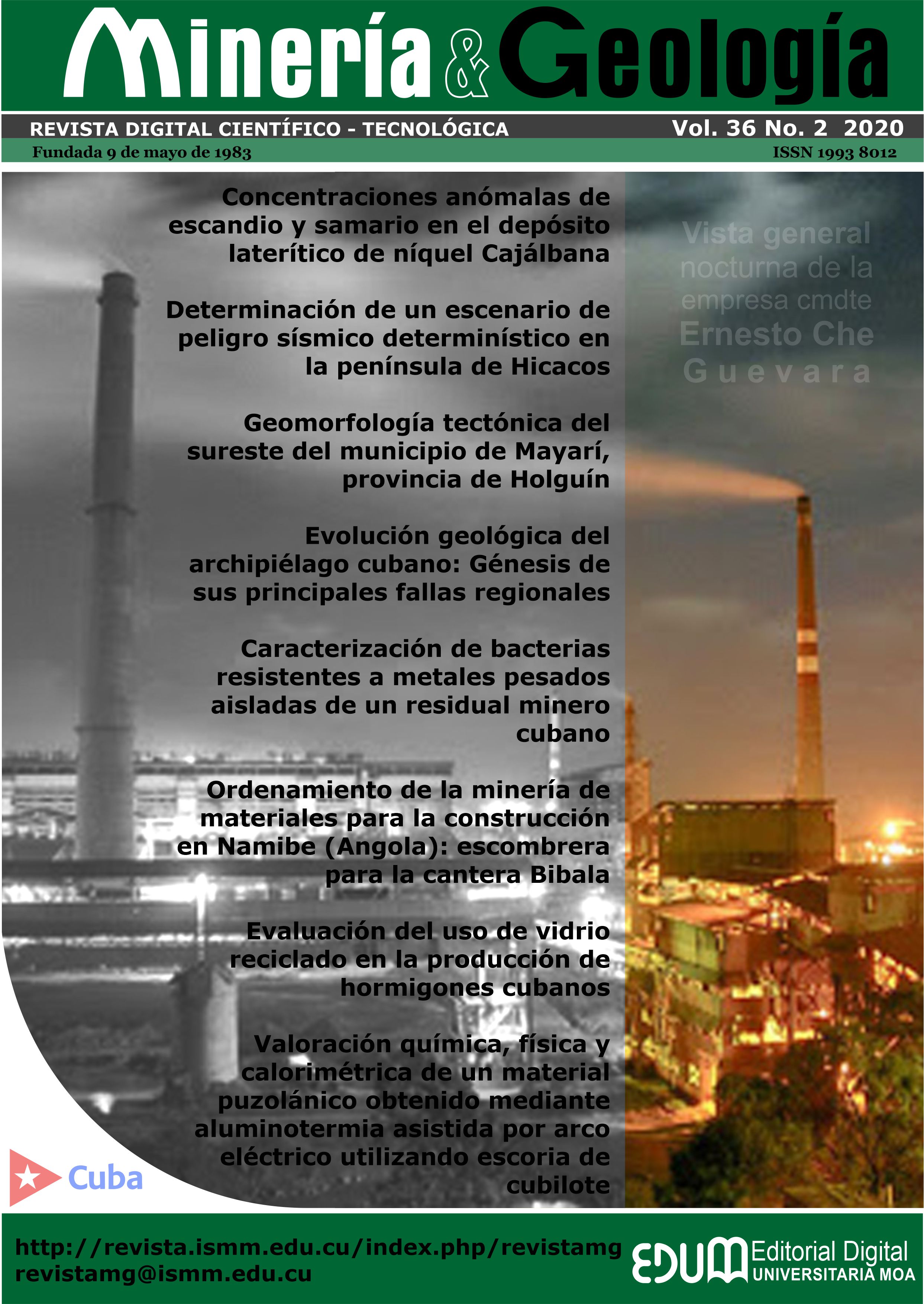Chemical, phasic and calorimetric evaluation of a pozzolanic material obtained by electric arc-assisted aluminothermy using cupola slag
Keywords:
cupola slag, aluminothermy, synthesized pozzolanic material, pozzolanic characterAbstract
The purpose of this study was to evaluate the chemical, phasic and calorimetric evaluation of a pozzolanic material obtained by electric arc-assisted aluminothermy using cupola slag to provide criteria on its pozzolanic nature. Chemical characterization of cupola slag and synthesized pozzolanic material (MPS) was performed by using analytical methods such as volatilization gravimetry, complex formation volumetry, UV-VIS spectrophotometry, atomic absorption spectrometry, and phase characterization using semi quantitative analysis by XRD. The pozzolanic character of cupola slag and MPS was evaluated by means of alkaline solubility tests and isothermal calorimetry in Ca(OH)2-Puzolana and Portland Cement (CP)-Pozzolan paste systems. Cupola slag does not contain more than 70% of SiO2, Al2O3 and Fe2O3 as indicated in NC TS 528: 2007 for its use as pozzolan and has 60 % amorphism, while the MPS complies with the provisions of the standard and presents a 30 % amorphism. The highest values of the Si and Al contents in the cupola slag respect to MPS and the zeolite studied are associated with the predominance of a non-periodic distribution of these chemical elements in the amorphous domains. Higher pozzolanic reactivity of the MPS respect to cupola slag obtained by isothermal Ca(OH)2-Pozolana and CP-Pozzolan calorimetry is attributed to a combination of amorphous character with the increasing of reactive phases result from chemical and phase modifications by using aluminothermy in an electric arc furnace.Downloads
References
Alujas, A. 2010: Obtención de un material puzolánico de alta reactividad a partir de la activación térmica de una fracción arcillosa multicomponente. Tesis doctoral. Universidad Central Marta Abreu de Las Villas.
Arvaniti, E. C.; Juenger, M. C. G.; Bernal, S. A.; Duchesne, J.; Courard, L.; Leroy, S.; Provis, J. L.; Klemm, A. y Belie, N. D. 2014: Determination of particle size, surface area, and shape of supplementary cementitious materials by different techniques. Materials and Structures, 48(11): 3687-3701. Consulta: 14/10/2019. Disponible en: https://doi.org/10.1617/s11527-014-0431-3.
Castro, M. T.; Adams, I. C.; Valdés, M. G.; Cordovés, A. I. P.; Horrutinier, Y. E. y Espinosa, L. M. 2013: Química Analítica. Equilibrios Homogéneos. La Habana: Félix Varela.
Crespo, A. C.; González, L. P.; Puchol, R. Q. y Scotti, A. 2019: Fundente para recargue por soldadura con arco sumergido a partir de ferrocromo-manganeso y escoria de la reducción simultánea de cromita y pirolusita. Soldagem & Inspeção, 24: e2424. Consulta: 14/10/2019. Disponible en: https://doi.org/10.1590/0104-9224/SI24.24.
Duart, J.; Sanz, J. y Verdeja, L. 2004: Aceros Aluminotérmicos. Nuevas Aplicaciones. Revista de metalurgia, 40(1): 56-64.
Hernández, R. A. C.; Durán, D. M. F. y Bustos, L. P. 2014: Reemplazo del agregado fino por escoria de horno de cubilote para la fabricación de concreto. Revista INGE CUC, 10(1): 83-88.
Hervé, D. M. y Garrido, M. V. 2012: Comparación de dos muestras de zeolita en la adsorción de humedad y remoción de olores. INFOMIN, 4(1): 21-31.
Norma cubana NC 439. 2014: Hierro y acero. Determinación del contenido total de silicio. Método gravimétrico. La Habana: Oficina Nacional de Normalización.
Norma cubana NC TS 528. 2007: Cemento Hidráulico-Puzolanas-Especificaciones. La Habana: Oficina Nacional de Normalización.
Pastor, R. C. 2015: Efecto de la adición de cal en las propiedades mecánicas y durabilidad de hormigones con altos contenidos en cenizas volantes silíceas. Tesis doctoral. Universidad Politécnica de Valencia.
Pérez, L. L.; Puchol, R. Q.; Perdomo, L. y Alujas, A. 2019: Potencialidad de la mezcla escoria de cubilote-cascarilla de laminación-viruta de aluminio para obtener un material puzolánico mediante aluminotermia. Minería y Geología, 35(4): 464-479.
Puchol, R. Q. 2014: Conceptualizaciones científico-técnicas sobre el diseño, obtención y desarrollo de fundentes para soldadura automática por arco eléctrico a partir de minerales y residuales sólidos industriales. Tesis doctoral. Universidad Central Marta Abreu de Las Villas.
Puchol, R. Q.; Pérez, C. R. G.; Crespo, A. C. y González, L. P. 2011: Evaluation of the SiO2-Al2O3-CaO-MgO System for agglomerate Fluxes across the optic Basicity and structural-chemical Criteria. Soldagem & Inspeção, 16(2): 137-145.
Ribalta, J. A.; Pérez, L. L. y Díaz, A. A. 2018: Influence of the Kind of Mineral Addition and the Seawater on the Hydration of a Portland Cement. In: Martirena, F. F. A. y Scrivener, K. (ed.) Calcined Clays for Sustainable Concrete. Vol. 16. Dordrecht: Springer.
Tuliani, S. S.; Boniszewski, T. y Faton, N. F. 1969: Notch toughness of commercial submerged-arc weld metal. Welding and Metal Fabrication, 37(8): 327-339.
Vizcaíno, L. M. 2014: Cemento de bajo carbono a partir del sistema cementicio ternario clínquer-arcilla calcinada-caliza. Tesis doctoral. Universidad Central Marta Abreu de Las Villas.
Published
How to Cite
Issue
Section
Copyright (c) 2020 Leidys Laura Pérez González

This work is licensed under a Creative Commons Attribution-NonCommercial 4.0 International License.
- Authors retain copyright and guaranteeing the right magazine to be the first publication of the work as licensed under a Creative Commons Attribution-NonCommercial that allows others to share the work with an acknowledgment of the work's authorship and initial publication in this journal.
- Authors may establish separate supplemental agreements for the exclusive distribution version of the work published in the journal (eg, place it in an institutional repository or publish it in a book), with an acknowledgment of its initial publication in this journal.
- Authors are allowed and recommended to disseminate their work through the Internet (e.g., in institutional telematic archives or on their websites) before and during the submission process, which can produce interesting exchanges and increase citations of the published work. (See The effect of open access)










